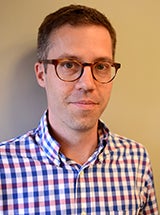
Christopher J. Lengner, PhD
Additional Titles:
Chair, Department of Biomedical Sciences
Member, Institute for Regenerative Medicine, Perelman School of Medicine
Member, NIH P30 Center for Molecular Studies in Digestive and Liver Diseases, Perelman School of Medicine
Director, Center for Animal Transgenesis
Member, Abramson Cancer Center
Johnson NM, Lengner CJ. MTORC1 and the Rebirth of Stemness Dev Cell 55: 113-115, 2020.
Song Y, Guerrero-Juarez CF, Chen Z, Tang Y, Ma X, Lv C, Bi X, Deng M, Bu L, Tian Y, Liu R, Zhao R, Xu J, Sheng X, Du S, Liu Y, Zhu Y, Shan SJ, Chen HD, Zhao Y, Zhou G, Shuai J, Ren F, Xue L, Ying Z, Dai X, Lengner CJ, Andersen B, Plikus MV, Nie Q, Yu Z. The Msi1-mTOR pathway drives the pathogenesis of mammary and extramammary Paget’s disease Cell Res 30: 854-872, 2020.
Efimova N, Yang C, Chia JX, Li N, Lengner CJ, Neufeld KL, Svitkina TM. Branched actin networks are assembled on microtubules by adenomatous polyposis coli for targeted membrane protrusion J Cell Biol 219: e202003091, 2020.
Sheng X, Lin Z, Lv C, Shao C, Bi X, Deng M, Xu J, Guerrero-Juarez CF, Li M, Wu X, Zhao R, Yang X, Li G, Liu X, Wang Q, Nie Q, Cui W, Gao S, Zhang H, Liu Z, Cong Y, Plikus MV, Lengner CJ, Andersen B, Ren F, Yu Z. Cycling Stem Cells Are Radioresistant and Regenerate the Intestine Cell Rep 32: 107952, 2020.
Berry CT, Liu X, Myles A, Nandi S, Chen YH, Hershberg U, Brodsky IE, Cancro MP, Lengner CJ, May MJ, Freedman BD. BCR-Induced Ca(2+) Signals Dynamically Tune Survival, Metabolic Reprogramming, and Proliferation of Naive B Cells Cell Rep 31: 107474, 2020.
Allensworth-James M, Banik J, Odle A, Hardy L, Lagasse A, Moreira ARS, Bird J, Thomas CL, Avaritt N, Kharas MG, Lengner CJ, Byrum SD, MacNicol MC, Childs GV, MacNicol AM. Control of the anterior pituitary cell lineage regulator POU1F1 by the stem cell determinant Musashi Endocrinology ndocrinology: , 2020.
Lengner CJ. MTorc1 at the Crossroads of Facultative Intestinal Stem Cell Activation Cell Mol Gastroenterol Hepatol 10: 857-858, 2020.
Caldwell BA, Liu MY, Prasasya RD, Wang T, DeNizio JE, Leu NA, Amoh NYA, Krapp C, Lan Y, Shields EJ, Bonasio R, Lengner CJ, Kohli RM, Bartolomei MS. Functionally distinct roles for TET-oxidized 5-methylcytosine bases in somatic reprogramming to pluripotency Mol Cell ol Cell: , 2020.
Tang AT, Sullivan KR, Hong CC, Goddard LM, Mahadevan A, Ren A, Pardo H, Peiper A, Griffin E, Tanes C, Mattei LM, Yang J, Li L, Mericko-Ishizuka P, Shen L, Hobson N, Girard R, Lightle R, Moore T, Shenkar R, Polster SP, Roedel CJ, Li N, Zhu Q, Whitehead KJ, Zheng X, Akers A, Morrison L, Kim H, Bittinger K, Lengner CJ, Schwaninger M, Velcich A, Augenlicht L, Abdelilah-Seyfried S, Min W, Marchuk DA, Awad IA, Kahn ML. Distinct cellular roles for PDCD10 define a gut-brain axis in cerebral cavernous malformation Sci Transl Med 11: eaaw3521, 2019.
Park Hanseul, Oh Jungju, Shim Gayong, Cho Byounggook, Chang Yujung, Kim Siyoung, Baek Soonbong, Kim Hongwon, Shin Jeain, Choi Hwan, Yoo Junsang, Kim Junyeop, Jun Won, Lee Minhyung, Lengner Christopher J, Oh Yu-Kyoung, Kim Jongpil In vivo neuronal gene editing via CRISPR-Cas9 amphiphilic nanocomplexes alleviates deficits in mouse models of Alzheimer’s disease. Nature neuroscience 22: 524-528, 2019.
The overarching goal of my research program is to gain an understanding of the molecular mechanisms that govern stem cell potency and how dysregulation of these mechanisms can contribute to disease onset and progression, including oncogenesis. My laboratory employs genetic, genomic, and single-cell analysis approaches in murine systems to address these fundamental questions, and, in parallel, utilizes human induced pluripotent cells and patient samples to translate findings into human systems. Using these approaches we have identified novel pathways underlying the somatic stem cell self-renewal and the ontogeny of hematopoietic and gastrointestinal cancers. These pathways are subsequently being assessed as potential points for therapeutic intervention in cancers and diseases of regenerative failure. We have also begun to unravel the hierarchical structure of the intestinal stem cell compartment with the ultimate goal of understanding how perturbations in this hierarchy contribute to disease states, including cancer, chronic inflammation, and regeneration in response to acute injuries such as ischemia or radiation damage.
Lab Members
Ning Li, M.D., Postdoctoral Fellow
Dong-Hun Woo, Ph.D., Postdoctoral Fellow
Angela Ddamba, Research Specialist
Ryan Cedeno, Graduate Student
Maryam Yousefi, Graduate Student (HHMI International Fellow)
Carla Hoge, Undergraduate (UPenn Vagelos Scholar)
Whitehead Institute for Biomedical Research (MIT) (2005 to 2010)
Ruth L. Kirschstein Postdoctoral Fellow, Stem Cell Biology and Genetics
Education:
PhD (Cell and Molecular Biology) University of Massachusetts Medical School, 2004
Contact:
University of Pennsylvania
School of Veterinary Medicine
3800 Spruce Street
Philadelphia, PA 19104
